Abstract
Low-rise construction is considered an effective method of integrated development of territories within the framework of creating agglomerations. In order to select new models of integrated development of territories, we set a goal to study the economic feasibility of implementing a housing project for the development of suburbania with individual housing construction objects, where quality control is a priority. The study included desk and field studies of the region's economy, location and environment, construction technology, and agglomeration development prospects. An information system for monitoring the quality of construction has been developed. The presented results show that the market of high-quality countryside real estate in Kazan is developing, and the location of the land plot of the project under study is characterized by good transport accessibility and environmental conditions. The concentration of housing construction in the Republic of Tatarstan is not overly concentrated in the Kazan agglomeration. The volume of new housing is scattered across the territory of the Republic of Tatarstan relatively evenly. The market for cottage settlements of the old format without a general concept is overfilled. Demand will shift towards organized settlements. At the same time, the demand for a comfortable environment within the cottage settlement will grow. The obtained conclusions can be used in the development of business plans for investment projects of integrated development in the Kazan agglomeration.
Keywords: Environmental planningfeasibility studieslow-rise constructionsuburbanizationsustainable urban development
Introduction
An increase in the urban population leads to an increase in population density due to an increase in the construction of high-rise residential buildings. High-rise residential buildings have some unique aspects. Research results show that the positive characteristics of the construction of high-rise residential buildings are manifested in attractive technical and economic indicators of the development business and a certain balance of the urban environment (in terms of proximity of social infrastructure). Negative parameters are manifested in the fact that they have a harmful effect on the psychological health of a person (Ahmad et al., 2017).
Urbanization, especially in developing countries, means that the global tradition of living in low-rise housing is giving way to living in urban apartments. This includes huge environmental and socio-cultural changes. High-rise urban development in comparison with low and medium-rise development have negative consequences in terms of flexibility of modernization for subsequent use.
Chinese scientists have determined that suburban and rural areas are an important manifestation of residents' life habits, historical context and regional characteristics (Ma et al., 2020). As a result, only a full understanding of suburban and rural development can be assumed on the urban development that is consistent with the spirit of sustainable development. At the same time, some studies show that the expansion of agglomerations, the transfer of agricultural land for housing construction and the relocation of citizens to cities do not necessarily harm the daily life of rural residents (Liu et al., 2020). However, residents of rural and urban areas increasingly have to rely on a remote work place for their livelihood. This indicates that on some territories, not only spatial restructuring is necessary, but also economic restructuring.
For sustainable development, housing energy efficiency issues have long came to the fore. Studies show that even abroad, where the cost of energy resources is noticeably higher than in Russia, homeowners are reluctant to seriously engage in energy saving. Moreover, for most people, housing energy efficiency is not the main motivating factor when choosing a home. According to the researchers, when promoting energy efficiency housing, developers first need to get people choosing such homes, appealing to their awareness of the positive impact on health and the community as a whole (Nakano & Washizu, 2018).
Problem Statement
The construction industry is overloaded with resource planning, risk management, and logistics issues that often lead to design defects, projects delays, material overconsumption, and contract disputes with contractors (Akinosho et al., 2020).
Permanent studies are being carried out in terms of reducing waste, costs and construction time, which has made the application of lean manufacturing concepts in civil works breaking classical paradigms in this area. Quality management has become an important topic for the construction industry recently. According to researchers, the value of low-quality products in construction remains significant and can "eat" up to 40% of the revenue of a construction organization (Mashwama et al., 2017). Construction projects contain many specific risks due to their complex nature. The lack of a quality management policy or limited participation of project participants in the quality management process will negatively affect both project management and the firms’ competitiveness. This also negatively affects the survival potential of construction firms in the industry. In the world practice, most participants have a positive attitude to quality management, although they are not able to evaluate it properly (Acikara et al., 2017).
A modern tool for monitoring the quality of urban objects construction is the technology of information modeling BIM, whose functions provide a great help in ensuring the quality standards of construction (Lou et al., 2017). In the world practice, the study focuses on schemes for improving the quality of construction that are not available in Russian practice – the impact of customer involvement in the process of purchasing construction materials. The results of the study show that customers do have a positive impact on the quality of the construction environment (Janipha et al., 2015). In low-rise construction, as a rule, the quality of construction is carried out voluntarily, by involving technical supervision specialists. Ranking the factors that affect the quality of construction, the researchers identified the human factor and the attitude of employees to the quality of work as primary. At the same time, the competence of an expert can be judged only when the latter uses a complete structure of construction quality inspection, consisting of a set of assessments that allow combining all the conclusions into one effective system (Zimmermann & Eber, 2017).
Research Questions
The implementation of new projects for integrated development of territories should be carried out only with a thorough and comprehensive study of the economic feasibility of the project. Another fundamentally new and important issue is the introduction of a new form of construction quality control. The segment of individual housing construction (IHC) is not a priority area of housing construction in the country, despite the fact that most part of the population wants to live in their own home, and the share of IHC in the total volume of housing under construction reaches 45-50%. Systemic disadvantages of the individual housing construction market:
- lack of project documentation;
- technical supervision only with the voluntary decision of the customer;
- lack of connection between the quality of construction and financial risks.
According to our hypothesis, the introduction of a system of quality control in IHC will increase the civility of the IHC market and will not manifest itself in over-regulation, will give a serious impulse to the qualitative growth of the housing sector.
Purpose of the Study
The purpose of our research is to substantiate the economic feasibility of implementing a new project of integrated development of territories by individual housing construction objects in the Kazan agglomeration. As part of our research, we also need to give a description of the construction quality control on the market of IHC objects:
- to evaluate the types of construction organization;
- to systematize shortcomings in the construction of residential facilities;
- to identify the main errors in the construction of objects;
- to determine the reasons for the lack of an effective mortgage lending system;
- to describe the development of the information environment.
Research Methods
We analyze cottage settlements from the developer with the status of "individual housing construction", stating a single concept, as well as offering ready-made houses. The analysis did not include houses in the private sector, including infill construction in villages, as well as houses in garden associations, as they do not correspond to the project concept and are not serious competitors of the project. The secondary offer is analyzed for reference only in settlements with a single concept and management company. The study analyzes the land market. Meanwhile, this product cannot be considered an analog of the project, since the project offers only plots with households and this is an important competitive advantage of the project. The subject of the analysis is suburban real estate for permanent residence. Currently, according to the Genplan Institute of Moscow, the average time for getting to work in Kazan is 33 minutes (Moscow Government, & Committee for Architecture and Urban Development of the City of Moscow, 2019). The analysis zone is defined as a comfortable distance from the city center with a travel time of 30-40 minutes. Preference is given to sites located within the borders of the city of Kazan, as the fact of Kazan registration provides access to the city infrastructure and is an important criterion for the buyer. The analyzed project can be classified as a business class with a budget significantly higher than the minimum. The main focus of the analysis is on direct analogs of a project with a similar class and budget. For information, the study analyzes examples of premium settlements and the most high-quality economy class settlements. The main focus of the analysis is on individual residential buildings for permanent residence as part of organized cottage settlements located within a 40-minute walk from the city center with a focus on business class. The research methodology is as follows (Table
Findings
The Republic of Tatarstan is traditionally among the leading regions in terms of macroeconomic indicators of the region. In terms of gross regional product, the republic ranks 7th among the subjects of the Russian Federation, in terms of agriculture and investment in fixed assets it ranks 4th, in terms of industrial production and construction it ranks 5th, in terms of housing delivery it ranks 6th. Kazan is one of the largest industrial, financial, commercial and tourist centers in Russia, a leading city in terms of investment in fixed assets and construction in the Volga region. Kazan confidently occupies a leading position among the regions in terms of the effectiveness of interaction with the authorities, the development of creative infrastructure and the general education of the population. The population of the republic, according to the Federal State Statistics Service at the beginning of 2020 is 3902888 people (Federal State Statistics Service for the Republic of Tatarstan, 2020). Projected population growth of 1% per year. The Republic of Tatarstan is one of the few regions where population growth exceeds mortality. The region has a stable increase in internal migration. There is an interest increase to individual housing due to the increase in the cost of multistorey construction by 8-12% compared to 2018 due to legislative changes, including the introduction of escrow accounts. The general conclusion is that the paying capacity of the population in Kazan will slightly grow against the background of general population growth and projected growth in real incomes, which characterizes the region as promising for investment in residential real estate (Ostashko, 2018).The location of the land plot is characterized by good transport accessibility and environmental situation (Figure
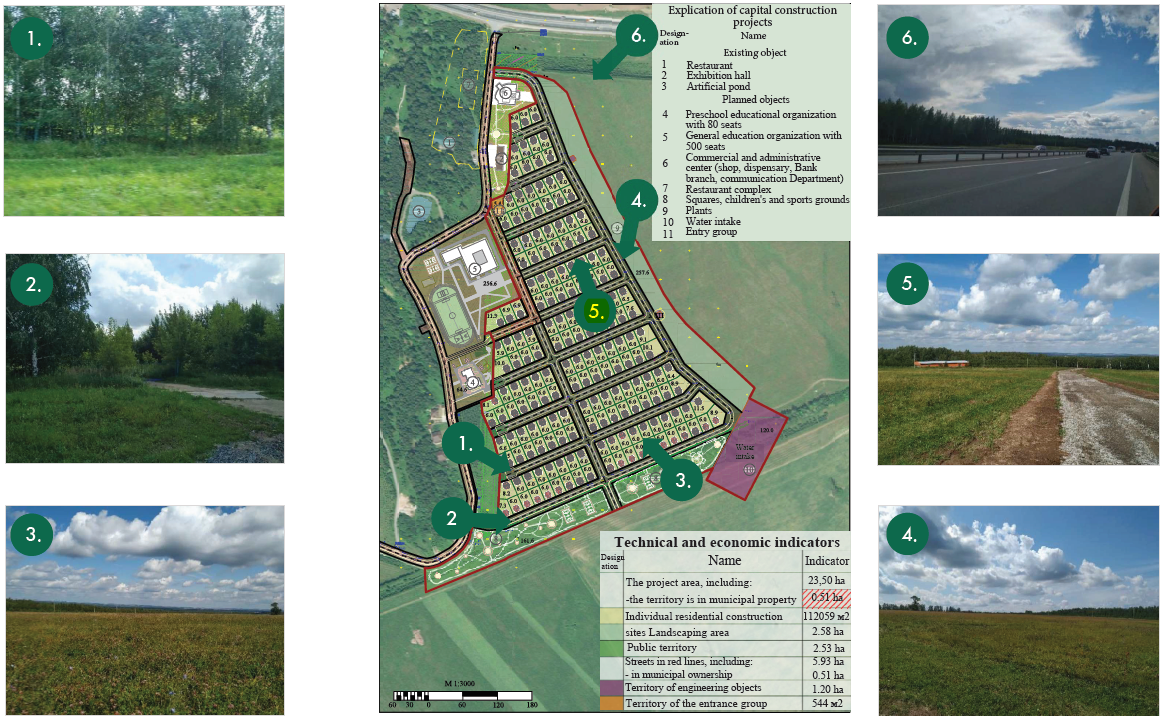
At the same time, the main advantages of the land plot are provided due to its location on the territory of the Kazan agglomeration (Table
One of the conditions for effective project implementation is a high-quality project environment. Next to the project is the hotel complex "Dubai", the infrastructure of which includes:
guest houses and a motel;
restaurant;
recreation area with outdoor pool;
sports complex;
equestrian sports club "Prestige".
All necessary infrastructure is located in the Derbyshki microdistrict and is 5-10 minutes away by car from the project (Figure
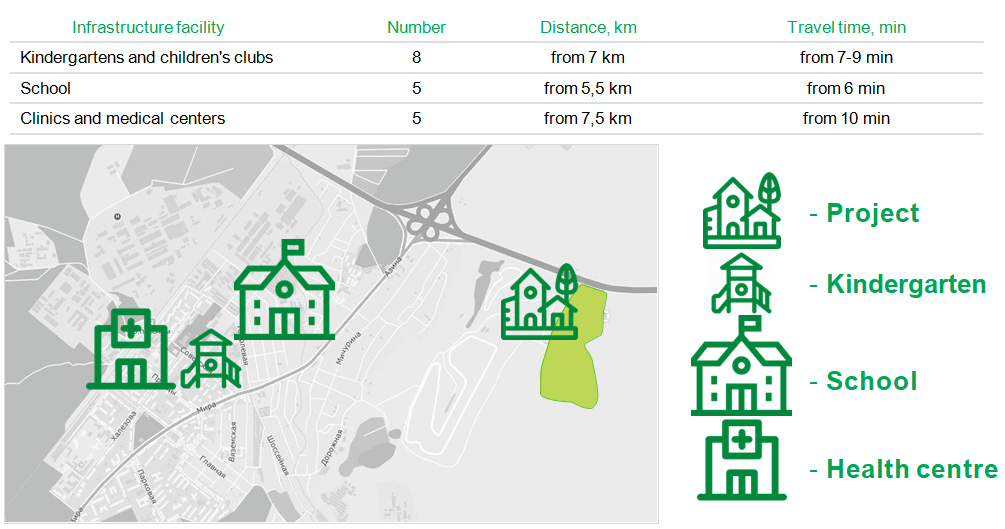
The General Plan of Kazan (until 2035) includes the construction of an urban main street of the 1st class along the Northern Meridian course of the railway, from Torfyanaya street to the M7 highway (Moscow Government, & Committee for Architecture and Urban Development of the City of Moscow, 2019). The highway should unload Mira street. It is planned to build two roads - along Lipatov street and on the other side of the railway. The number of lanes in one direction is 2. It is planned to expand highways inside the Derbyshki microdistrict, including Main street. The master plan includes the development of road networks to the East of the project, but the planned implementation period is until 2035. The general plan assumes the development of railway communication along the Northern Meridian course of the railway. It is planned to increase the number of ground transport trips. Thus, in the future 10-15 years, the transport infrastructure near the project will be developed. Meanwhile, new road networks will not be built in the next 5-10 years, so they will not affect the project (Table
JWT technology (Japan Wood Technologies) is a Japanese wooden house construction technology. This is a half-timbered construction technology that uses a post-and-beam structure reinforced with wall panels. This technology ensures the strength of the supporting structure and gives a certain freedom in the design of buildings. Factory production of the prefabricated house using JWT technology minimizes the likelihood of human error and provides the possibility to quickly assemble the house and finish the interior.
Most of the competitive objects are located in the Privolzhsky district in the south of the city (Table
Demand and prices on the market have been growing since 2015. The increase in prices for suburban real estate is due to the increase in the cost of real estate in the city. The budget for buying premium class homes starts from 10.5 million rubles in white box finishing in cottage settlement "Volzhskaya Gavan" for a house of 140 sq. m. At least 2 million rubles should be spent on finishing. Thus, the minimum purchase budget with finishing is 12.5 million rubles. In cottage settlement "Primavera", taking into account the discount, the minimum purchase budget in white box finishing is 15 million rubles for a house of 245 sq.m.
The budget for buying business class homes starts from 5.4 million rubles in white box finishing in the cottage settlement "Blue Lake". At least 1,6 million rubles should be spent on finishing. The minimum purchase budget with finishing is 7 million rubles for a house of 80 sq. m. The budget for buying houses from an economy class developer in cottage settlements with finishing starts from 4.5 million rubles for a house of about 100 sq. m.
The cost of land strongly depends on the class of the cottage and the quality of infrastructure. In business class settlements, the cost of land is 280 000 – 350 000 Rub. The cost of land in neighboring settlements may differ significantly due to the availability of roads, gas, electricity and water supply, the status of Kazan, security, children's and sports grounds. In many cases, there is no direct dependence on the distance to Kazan, but there is a dependence on the time to get to the city center.
At the moment, the market for high-quality suburban real estate of business and comfort class is characterized by a low volume of supply. The most competitive cottage settlements for the project are the "Blue lake" under construction, as well as the planned "Bright Park". "Bright Park" cottage settlement has the greatest competitive potential for the project as it offers a quality product from a well-known developer (Unistroy) in a popular location with a minimum budget of 7 million rubles. The project will start selling townhouses as the cheapest and therefore most liquid product. 420 households, including townhouses, have been declared for sale. Settlements offering houses and land plots for development will have a weaker competitive impact on the project. All competitive projects are built of brick, expanded clay or monolith (Musin et al., 2020). Wooden and light-frame houses are represented individually. Light-frame houses are considered economical housing due to the low quality of the existing offer. JWT technology is not available on the market. The location within the borders of Kazan is important for buyers. Less important is the location of the project on the city borders (Gareev et al., 2020).
The development of agglomeration phenomena in the Republic of Tatarstan also contributes to increasing demand for suburban real estate objects. In particular, the republic has a concentration of housing construction, population and productive forces in six districts of the Kazan agglomeration. To identify the balance of territorial development and its correlation with the housing construction market (which determines its trend), we calculated the Herfindahl-Hirschman index (HHI) for the volume of housing construction, population concentration, and the number of jobs by districts (cities) of the Republic of Tatarstan (Eremenko & Gareev, 2019). The maximum value of the Herfindahl-Hirschman index is 10000 and indicates a monopoly concentration in the study area. An index value more than 1800, and a low level less than 1000 can indicate a high level of concentration of the studied indicator in the region.
The Herfindahl-Hirschman index for assessing, for example, the concentration of housing construction (HHIconstruction) by districts (cities) of the Republic of Tatarstan is calculated as the sum of the squares of the percentages of housing construction in a particular district (city) of the Republic of Tatarstan in relation to the total housing construction in the Republic of Tatarstan:
where:
Ci - the share of each city (district) in the total volume of housing construction in the Republic of Tatarstan.
One of the reasons for the significant volume of housing construction on the territories of the Kazan agglomeration is the lack of large vacant land plots for construction in Kazan and the exit of developers to satellite areas. In general, this leads to a pendulum migration, although it allows implementing projects for integrated development of territories. Due to the lack of official data, the compared indicators in the same time series contain incomplete data (Figure
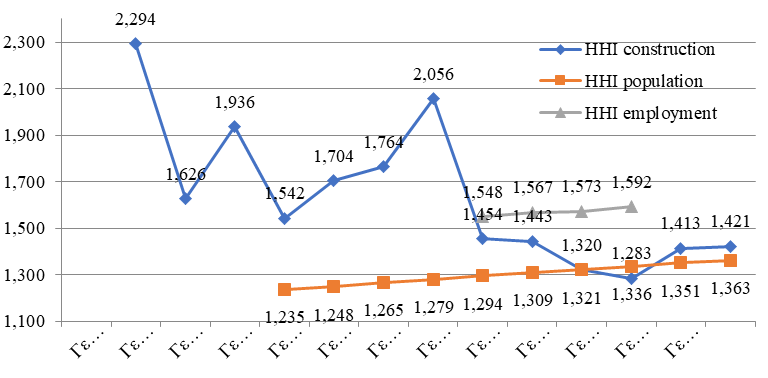
The concentration of housing construction in the Republic of Tatarstan is not overly concentrated in the Kazan agglomeration. The volume of new housing is scattered across the territory of the Republic of Tatarstan relatively evenly. At least in recent years, due to more efficient public administration (including through targeted state programs), housing construction has been at a stable level in most regions of the republic. The values of the Herfindahl-Hirschman index for the studied indicators (housing construction, population, work places) in recent years (from 2014 to 2018) are close to each other. This indicates a relative balance of territorial development and distribution of productive forces in the regions of the Republic of Tatarstan. Another important task in the organization of complex development is the introduction of a quality control system for construction. In order to improve the quality of construction, the development company and the Kazan State University of Architecture and Engineering signed an agreement on the development of a certification system (inspection control). The tasks of inspection control are:
- verification of the quality compliance of work performed with the results of engineering surveys, environmental requirements, requirements of technical regulations, requirements of company standards;
- verification of compliance of completed works and materials, products, and equipment used in the construction process with the requirements of regulatory documents and project documentation;
- control over the quality and correct use of the materials, technologies, products and equipment.
Stage 1 of the inspection control is checking the correct reinforcement, installation of formwork, depth of foundation and thickness of the sand cushion (Figure
- project ground coat level (checked by reference points);
- deepening of the foundation (compliance with the project);
- location of the foundation tape (compliance with the project);
- height and width of the foundation tape (compliance with the project);
- reinforcement of the foundation tape (compliance with the project);
- the protective layer of reinforcement (compliance with the project);
- installation sites of anchor bolts and "horudaun" (compliance with the project, the visual checking of the position of anchor bolts on two or more axes).
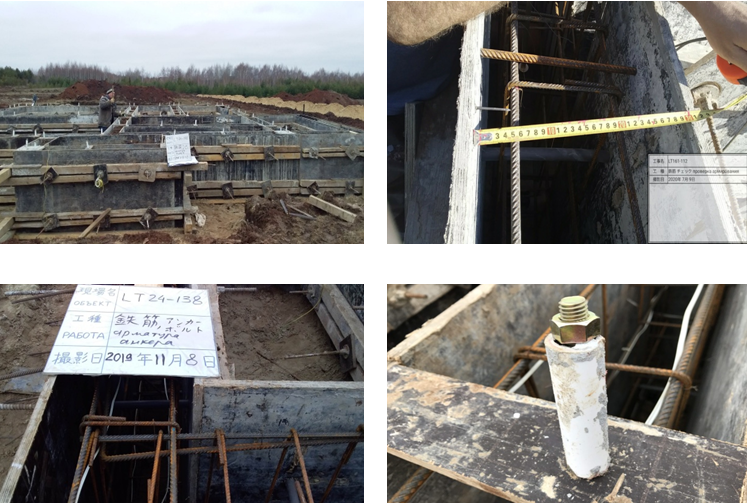
Phase 2 of inspection – checking the ready foundation (surface quality and strength of concrete foundation, location of anchors, presence of a waterproofing layer and foundation warming quality). In this article, we will only describe the names of the subsequent stages of inspection control, and a detailed description will be provided in our next article.
Stage 3 of the inspection control - checking the wooden frame of the building (matching the location of the frame elements of projects, checking the fastening elements).
Stage 4 of inspection control - checking the thermal insulation of walls and coatings (compliance of the used thermal insulation with the project and its correct location).
Stage 5 of the inspection control - checking the finished house with interior and exterior finishing.
In the Russian Federation, there is no legal regulation of technical control over the quality of construction of individual housing construction objects. Our suggested certification system is not just a technical supervision, but a system integrated with the system of bank lending and insurance. At the moment, we have reached previous agreements with these financial institutions, and they have confirmed the demand for a quality control system for building houses.
To automate the certification process, we have developed a prototype of an information system that unites all participants in the construction quality control (customers, contractors and inspectors) in a single information field – DomPro (2020) (Figure
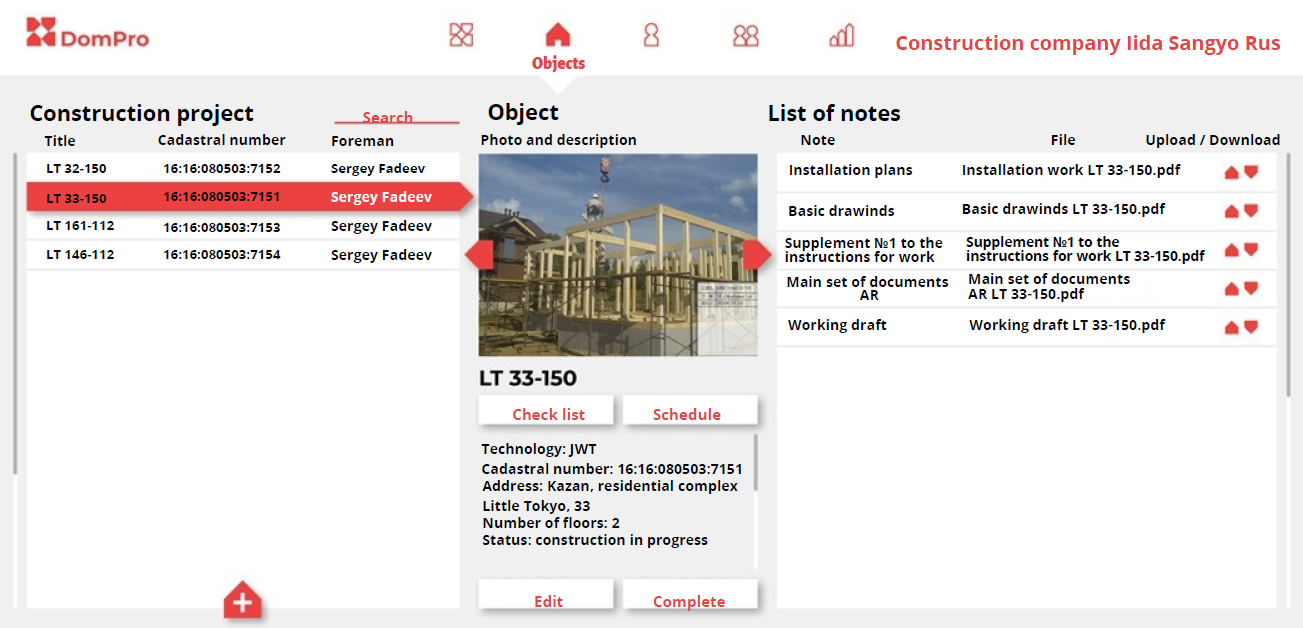
The certification system is based on the certification of technical supervision specialists at the Kazan State University of Architecture and Engineering for further inspection of low-rise construction objects. The DomPro certification system is aimed at improving the quality of construction using any construction technology.
In the world practice for inspection of individual stages of construction (for example, remote control of concrete formwork during concrete laying) a combination of information and communication technologies that integrate mobile phones and smart glasses with augmented reality is actively used (Moon, 2017). In our case, we are at the beginning of establishing a quality control system, but the use of such technologies is only a matter of time.
Conclusion
In the medium term, following the market of multi-storey housing in Kazan, the trend of growth in demand and prices for ready-made suburban real estate on the market of cottage settlements will continue. Despite the growing demand, the market for cottage settlements of the old format without a general concept is oversaturated. The existing supply of low-quality homes and development sites will not be absorbed by the market in the coming years. The most popular will be suburban real estate of medium size (80-150 sq. m.) with a minimum budget for the sale of households of no more than 5-6 million rubles. Thus, in the future, the market for high-quality suburban real estate in Kazan will develop. With the appearance of high-quality projects, demand will shift in their direction, and villages without a common concept will lose customers. In the growing competition, it is necessary to create a high-quality product and quickly bring it to the market, professionally marketing its advantages. The concentration of the studied indicators has been increasing in recent years. For example, per capita, the largest volumes are observed in the areas of the Kazan agglomeration. Citizens' demands for the quality of housing under construction are growing. On the other hand, the quality of construction is a condition for bank lending and acceptable, not inflated insurance rates.
References
- Acikara, T., Kazaz, A., & Ulubeyli, S. (2017). Evaluations of construction project participants’ attitudes toward quality management in Turkey. Procedia Engineering, 196, 203-210.
- Ahmad, T., Aibinu, A., & Thaheem, M.J. (2017). The effects of high-rise residential construction on sustainability of housing systems. Procedia Engineering, 180, 1695-1704.
- Akinosho, T. D., Oyedele, L. O., Bilal, M., Ajayi, A. O., Delgado, M. D., Akinade, O. O., & Ahmed, A. A. (2020). Deep learning in the construction industry: A review of present status and future innovations. Journal of Building Engineering, 32, 101827.
- DomPro (2020). Main page. http://iidadom.ru/
- Eremenko, M. M., & Gareev, I. F. (2019). Research on the relationship between housing construction and sustainable development of territories. Russian Journal of Housing Research, 6(1), 333-376.
- Federal State Statistics Service for the Republic of Tatarstan (2020). Population of municipalities of the Republic of Tatarstan. https://tatstat.gks.ru/storage/mediabank/%D0%9C%D0%9E%D1%87%D0%B8%D1%81%D0%BB2020_308759_311478.pdf
- Gareev, I. F., Khafizov, A. F., Mukhametova, N. N., Khusnutdinov, F. F., & Efimova, A. A. (2020). Research on the needs of the Kazan agglomeration population in modern low-rise construction facilities. Russian Journal of Housing Research, 7(1), 97-126.
- Janipha, N. A. I., Ahmad, N., & Ismail, F. (2015). Clients’ involvement in purchasing process for quality construction environment. Procedia-Social and Behavioral Sciences, 168, 30-40.
- Liu, L., Gao, X., Zhuang, J., Wu, W., Yang, B., Cheng, W., & Deng, O. (2020). Evaluating the lifestyle impact of China’s rural housing land consolidation with locational big data: A study of Chengdu. Land Use Policy, 96, 104623.
- Lou, J., Xu, J., & Wang, K. (2017). Study on construction quality control of urban complex project based on BIM. Procedia Engineering, 174, 668-676.
- Ma, C., Jiang, Y., & Qi, K. (2020). Investigating the urban–rural integrated town development strategy on the basis of the study of rural forms in Nantong, China. Frontiers of Architectural Research, In Press.
- Mashwama, N., Aigbavboa, C., & Thwala, D. (2017). An assessment of the critical success factor for the reduction of cost of poor quality in construction projects in Swaziland. Procedia Engineering, 196, 447-453.
- Moon, S. (2017). Application of mobile devices in remotely monitoring temporary structures during concrete placement. Procedia Engineering, 196, 128-134.
- Moscow Government, & Committee for Architecture and Urban Development of the City of Moscow (2019). Draft General plan of the city district of Kazan. https://fgistp.economy.gov.ru/files/9270100002020302201903272/f5ggXdD.pdf
- Musin, B. S., Ibragimov, R. A., & Bogdanov, R. R. (2020). Rationing of technological operations in low-rise building on the example of the residential complex «Little Tokyo». Izvestiya KGASU, 2(52), 73-80.
- Nakano, S., & Washizu, A. (2018). Acceptance of energy efficient homes in large Japanese cities: Understanding the inner process of home choice and residence satisfaction. Journal of Environmental Management, 225, 84-92.
- Ostashko, V. Y. (2018). The analysis of tendencies and development of the territorial market of low-rise residential development (on the example of JSC "Development corporation" Antey"). Real Estate: Economy, Management, 1, 87-91.
- Zimmermann, J., & Eber, W. (2017). Criteria on the value of expert’s opinions for analyzing complex structures in construction and real estate management. Procedia Engineering, 196, 335-342.
Copyright information

This work is licensed under a Creative Commons Attribution-NonCommercial-NoDerivatives 4.0 International License.
About this article
Publication Date
30 April 2021
Article Doi
eBook ISBN
978-1-80296-105-8
Publisher
European Publisher
Volume
106
Print ISBN (optional)
-
Edition Number
1st Edition
Pages
1-1875
Subjects
Socio-economic development, digital economy, management, public administration
Cite this article as:
Sternik, S. G., Gareev, I. F., & Khafizov, A. F. (2021). Introduction Of Digital Technologies In Quality Control Processes Of Low-Rise Construction. In S. I. Ashmarina, V. V. Mantulenko, M. I. Inozemtsev, & E. L. Sidorenko (Eds.), Global Challenges and Prospects of The Modern Economic Development, vol 106. European Proceedings of Social and Behavioural Sciences (pp. 313-326). European Publisher. https://doi.org/10.15405/epsbs.2021.04.02.39

